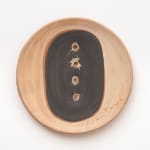
Lucio Fontana Argentine-Italian, 1899-1968
Concetto Spaziale, 1953-55
Painted terracotta
32 x 32 cm. (12 5/8 x 12 5/8 in.)
Copyright The Artist
Further images
Fontana learned his father's trade as a sculptor of graveyard memorials and his early sculptural works were reflective of this traditional and figurative influence. Fontana found great enjoyment working on...
Fontana learned his father's trade as a sculptor of graveyard memorials and his early sculptural works were reflective of this traditional and figurative influence. Fontana found great enjoyment working on ceramics throughout his career and the medium is the domain in which he experimented the most artistically - his sculptures mark the very genesis of his unremitting exploration of Spatialism.
Throughout his career, Fontana's sculptures become increasingly abstract. From 1949 onwards, he began his so-called 'Spatial Concept' series, consisting of holes or slashes punctured through the surface of his canvases, effectively cutting between the space occupied by the viewer, through the surface of the canvas, to the infinite space that lies beyond. Fontana saw this as evocative of infinity, claiming 'I have created an infinite dimension'. Fontana first produced his 'buchi' (holes) in 1948/49 and he devised the generic title 'Concetto Spaziale' ('spatial concept') for these works and used it for almost all his subsequent paintings. In 1951, the artist experimented with puncturing ceramic for the first time, utlisiing the same techniques, forcibly piercing the surface of the clay and highlighting its materiality. In Concetto Spaziale (1953-55) the finish, colour and texture is fundamental in its manifestation, allowing the silence of the cosmos prevail. Interrupted by only a few holes, which follow a straight line on an opaque ceramic surface, Fontana became increasingly influenced by his theories on spatialism, with terracotta works such as this depicting the 'buchi' for which he is most widely known. Fontana continued to experiment with these punctures until the year of his death in 1968.
Throughout his career, Fontana's sculptures become increasingly abstract. From 1949 onwards, he began his so-called 'Spatial Concept' series, consisting of holes or slashes punctured through the surface of his canvases, effectively cutting between the space occupied by the viewer, through the surface of the canvas, to the infinite space that lies beyond. Fontana saw this as evocative of infinity, claiming 'I have created an infinite dimension'. Fontana first produced his 'buchi' (holes) in 1948/49 and he devised the generic title 'Concetto Spaziale' ('spatial concept') for these works and used it for almost all his subsequent paintings. In 1951, the artist experimented with puncturing ceramic for the first time, utlisiing the same techniques, forcibly piercing the surface of the clay and highlighting its materiality. In Concetto Spaziale (1953-55) the finish, colour and texture is fundamental in its manifestation, allowing the silence of the cosmos prevail. Interrupted by only a few holes, which follow a straight line on an opaque ceramic surface, Fontana became increasingly influenced by his theories on spatialism, with terracotta works such as this depicting the 'buchi' for which he is most widely known. Fontana continued to experiment with these punctures until the year of his death in 1968.
Provenance
Private Collection, FerraraGalleria Il Castello, Milan
Private Collection, Biella
Galleria Tucci Russo, Torre Pellice
Private Collection, Italy
展览
London, Robilant+Voena, Immaterial: Fontana Ceramics, 15 October - 20 December 2019, no. 35, illustrated in colourLondon, Robilant+Voena, The Fontana Phenomenon: From Seaside to Studio, 24 July - 25 September 2020
Paris, Robilant+Voena, Fontana Ceramics: A Private Exhibition of Lucio Fontana's Pioneering Ceramics, 19 May - 2 July 2021












